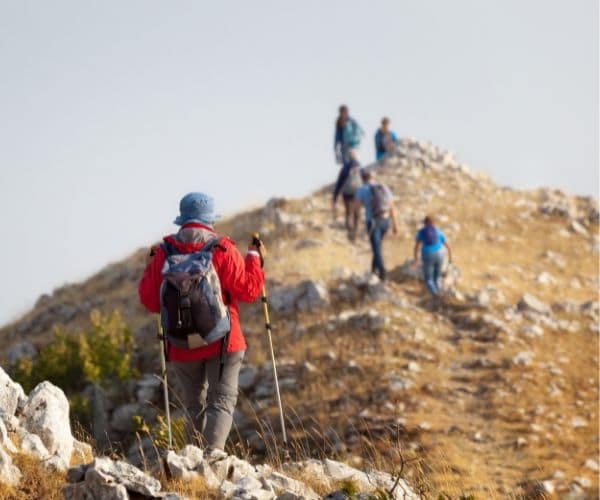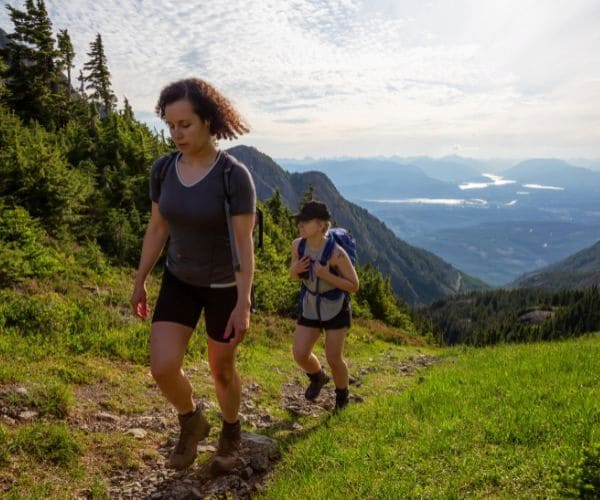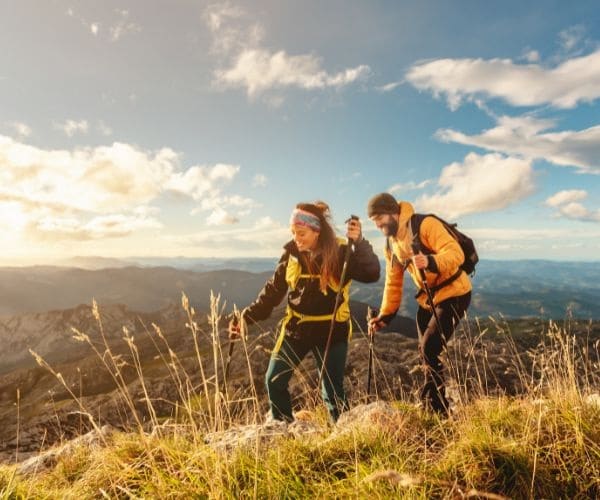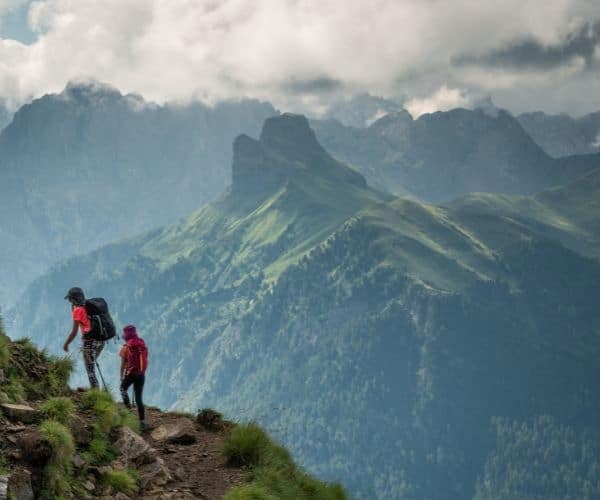Planning a high-altitude trek? Whether you’re aiming for Everest Base Camp or summiting Kilimanjaro, it’s vital to understand the risks of altitude sickness. While the views are stunning and the experience unforgettable, the thin mountain air can take a toll on your body if you’re not properly prepared.
The higher you hike, obviously the more at risk you are from suffering from altitude sickness, and everyone will experience symptoms in slightly different ways, with some suffering more than others.
To help trekkers understand what altitude sickness is, we’ve outlined the key points – how to prevent it, what to do if symptoms arise, and which locations carry the highest risk. Being well-informed could be the difference between a trip of a lifetime and a serious health emergency.
What is altitude sickness?

Altitude sickness, also known as Acute Mountain Sickness (AMS), occurs when your body struggles to adjust to reduced oxygen levels at high elevations. As you ascend, the air becomes thinner and your body receives less oxygen with every breath.
Symptoms of AMS
Symptoms typically begin above 2,500 metres (8,200 feet) and can range from mild to life-threatening:
Mild AMS (common and manageable):
- Headache
- Fatigue or weakness
- Dizziness or light-headedness
- Nausea or vomiting
- Difficulty sleeping
- Loss of appetite
Moderate to Severe AMS:
- Persistent headache that doesn’t improve with medication
- Breathlessness at rest
- Lack of coordination or confusion
- Severe vomiting
- Coughing up frothy sputum (a sign of pulmonary oedema)
Symptoms can appear within 6–24 hours of ascent and should never be ignored.
When altitude sickness becomes an emergency

The different levels of altitude sickness, how different people will experience different symptoms at different times.
In some cases, altitude sickness can progress into more serious conditions that require immediate descent and medical attention.
High-Altitude Pulmonary Oedema (HAPE)
- Fluid builds up in the lungs.
- Symptoms: Shortness of breath at rest, a persistent cough (often with frothy sputum), chest tightness, blue lips or nails.
High-Altitude Cerebral Oedema (HACE)
- Swelling of the brain due to lack of oxygen.
- Symptoms: Confusion, loss of coordination (ataxia), hallucinations, and altered mental state.
Emergency Rule: If someone is unable to walk in a straight line or shows sign
Treatment: remedies and medications

If symptoms arise, take them seriously and respond quickly.
Immediate Actions
- Stop ascending until symptoms resolve.
- Rest and stay hydrated.
- Descend if symptoms persist or worsen.
- Avoid alcohol, as it can worsen dehydration and oxygen deprivation.
Medications
- Acetazolamide (Diamox): A commonly prescribed drug that helps you acclimatise faster by acidifying the blood to increase breathing rate.
- Dexamethasone: A steroid used for severe AMS and HACE.
- Nifedipine: Sometimes used for HAPE to reduce pulmonary pressure.
Always consult a travel or mountain medicine specialist before your trip, as these medications require proper dosage and timing.
Helping suffers of severed altitude before emergency treatment arrives
If you’re in a remote location or help is delayed, these immediate steps can stabilise someone suffering from HAPE or HACE:
- Initiate Descent Immediately
- Descending just 500–1,000 metres (1,600–3,300 feet) can make a life-saving difference.
- Do not wait for helicopter evacuation if descent on foot or by mule is possible.
- Administer Oxygen
- If portable oxygen is available, use it at a flow rate that improves symptoms.
- Monitor with a pulse oximeter if you have one.
- Use a Portable Hyperbaric Bag (if available)
- Devices like the Gamow bag simulate descent by increasing pressure inside a sealed bag.
- They are used when descent is not immediately possible.
- Keep the Person Warm and Rested
- Remove any tight clothing and insulate them with dry layers and blankets.
- Avoid exertion – they should not walk under their own power if severely affected.
- Administer Medication (if trained and advised by a medical professional)
- Dexamethasone for HACE – reduces brain swelling.
- Nifedipine for HAPE – lowers pulmonary blood pressure.
- Acetazolamide (Diamox) may help if not already taken earlier.
- Only administer medication if you are confident in dosage and have medical clearance pre-trip.
- Stay Calm and Monitor Continuously
- Assign someone to monitor the patient constantly.
- Track symptoms, breathing rate, and level of consciousness.
- Prepare evacuation plan or contact mountain rescue as soon as possible.
Never leave the person alone and never assume they’ll “sleep it off.”
Prevention: How to reduce your risk

Altitude sickness is highly preventable with the right approach. Preparation, pacing, and listening to your body can make all the difference. Here’s how to significantly lower your risk of getting sick at high elevation:
Ascend slowly
Rushing your ascent is one of the biggest contributors to AMS. Your body needs time to adapt to lower oxygen levels.
- Follow the “climb high, sleep low” rule: This means ascending to a higher elevation during the day and then descending slightly to sleep at a lower altitude.
- Gain altitude gradually: Once above 3,000 metres (around 10,000 feet), don’t climb more than 300–500 metres (1,000–1,600 feet) per day.
- Build in acclimatisation days: For every 1,000 metres of elevation gained, take a rest day or spend two nights at that altitude to help your body adjust.
Even if you feel great, stick to the schedule. AMS can strike suddenly and unpredictably.
Hydrate and eat well
Dehydration and poor nutrition increase your risk of altitude problems.
- Drink regularly: Aim for 3–4 litres of water per day, more if trekking in dry or windy climates. Urine should be pale yellow – a good sign of hydration.
- Avoid caffeinated and sugary drinks in excess, as they can contribute to dehydration.
- Eat high-carb, low-fat meals: Carbohydrates are easier to metabolise at altitude and provide quick energy.
Snack often – energy levels can dip quickly in thinner air, even when you’re not hungry.
Avoid alcohol and sleeping pills
Alcohol and sedatives suppress the respiratory system – the opposite of what you want when trying to acclimatise.
- Avoid alcohol altogether in the first few days at altitude, and drink in strict moderation (if at all) after that.
- Skip sleeping pills unless advised by a doctor. They can worsen oxygen deprivation during sleep and mask early symptoms of AMS.
- Warm drinks, herbal teas (like ginger or chamomile), and earplugs can help improve sleep quality without side effects.
Consider acclimatisation hikes
Pre-trek acclimatisation is one of the best ways to prepare your body for the challenge ahead.
- Spend a few nights at moderate altitude (2,000–3,000 m) before ascending higher. Many trekking hubs are at ideal pre-acclimatisation altitudes (e.g., Cusco, Leh, Namche Bazaar).
- Do short hikes from your base to slightly higher altitudes during the day, then return to sleep lower.
- Use acclimatisation days wisely – they’re not for complete rest, but gentle walking and gaining altitude slowly.
Take preventive medication
Some trekkers benefit from taking acetazolamide (Diamox) preventively, especially if they have:
- A previous history of AMS
- A tight trekking schedule with rapid altitude gain
- Limited opportunity for acclimatisation
Diamox works by increasing your breathing rate and helping your body adjust more quickly to lower oxygen levels. It’s typically started 1–2 days before reaching altitude and continued for several days during ascent.
Always consult a travel doctor before using altitude medications. Side effects can include tingling in fingers and altered taste.
Know the early signs
Recognising symptoms early allows you to take action before the situation worsens.
- Headache + one other symptom (nausea, dizziness, poor sleep, etc.) is enough to indicate mild AMS.
- Use a pulse oximeter to track your blood oxygen saturation (SpO₂). While values naturally drop with altitude, a sharp decline over time may signal a problem.
- Be honest with yourself: Don’t downplay symptoms to avoid delaying the group or missing the summit.
Have a daily check-in to share how everyone is feeling. Mild symptoms in one person can help prompt early interventions for the whole group.
Other risks associated with altitude
Besides AMS, altitude poses other health and environmental challenges:
Hypothermia & Frostbite: Temperatures can plummet, even in dry climates.
Dehydration: High respiration rate causes fluid loss.
Increased UV Exposure: Thinner atmosphere = stronger UV rays. Wear high-SPF sunscreen and sunglasses.
Altitude-induced Insomnia: Rest can be difficult; some people find melatonin helpful.
Poor Decision-Making: Lack of oxygen can impair judgement and reaction time.
Preparation tips for trekkers
- Pack appropriately: layers, waterproof gear, medical kit, snacks, sunscreen.
- Carry a first aid kit with altitude-specific medications.
- Buy trekking insurance that covers high-altitude trekking and emergency evacuation.
- Let someone know your itinerary and emergency contacts.
- Consider hiring experienced local guides or porters familiar with the terrain and emergency procedures.
When to turn back
One of the most important rules in altitude trekking: the mountain will always be there.
If you or someone in your group shows signs of worsening altitude sickness, do not push forward. Delaying descent can be deadly. Always put safety first.
High-risk locations for altitude sickness
Certain popular trekking destinations are well above the threshold where altitude sickness becomes a risk. Here are some well-known spots around the world:
Asia
Everest Base Camp, Nepal – 5,364 m (17,598 ft)
Annapurna Circuit, Nepal – max 5,416 m (17,769 ft) at Thorong La Pass
Ladakh, India – Leh sits at 3,500 m (11,500 ft)
Tibet Plateau – Lhasa: 3,656 m (11,990 ft); Everest North Base Camp: 5,150 m (16,896 ft)
South America
Cusco, Peru – 3,400 m (11,154 ft)
Inca Trail, Peru – max 4,215 m (13,828 ft) at Dead Woman’s Pass
La Paz, Bolivia – 3,640 m (11,942 ft)
Aconcagua, Argentina – 6,961 m (22,838 ft), highest peak in the Americas
Africa
Mount Kilimanjaro, Tanzania – 5,895 m (19,341 ft)
Mount Kenya – 5,199 m (17,057 ft)
North America
Mount Whitney, California, USA – 4,421 m (14,505 ft)
Rocky Mountain National Park, Colorado, USA – up to 4,345 m (14,255 ft)
Mount Rainier, Washington, USA – 4,392 m (14,411 ft)
Europe
Mont Blanc, France/Italy – 4,809 m (15,777 ft)
Matterhorn, Switzerland – 4,478 m (14,692 ft)
Gran Paradiso, Italy – 4,061 m (13,323 ft)
Even though some Alpine treks start lower, rapid ascents (especially via cable car) can still trigger AMS.
Preparation is key
Altitude sickness is nothing to fear — if you’re prepared. With the right knowledge, planning, and respect for the mountains, you can significantly reduce your risk and enjoy the journey safely.
Remember: listen to your body, pace yourself, and don’t let summit fever override good judgement.
Get Hiking & Trekking Insurance from SportsCover Direct
Trekking at high altitude is an awe-inspiring experience but with thinner air comes increased risk. Altitude sickness can strike anyone, regardless of age or fitness, and in severe cases, it can turn a dream trek into a medical emergency.
That’s why having specialist trekking insurance that covers altitude sickness is absolutely essential.
Altitude-related illnesses can require urgent treatment, such as evacuation to a lower altitude or helicopter rescue from remote mountain areas – services that can cost thousands without proper insurance. Add to that the potential for hospital care, medication, or even repatriation, and you’ll see how quickly costs can spiral.
SportsCover Direct offers comprehensive hiking and trekking insurance designed for high-altitude adventures. Our policies cover medical expenses, helicopter evacuation, trip cancellation, and stolen gear – giving you the confidence to focus on your journey, not the “what ifs”.
With policies tailored for trekkers and high-altitude explorers, it’s a small investment for serious peace of mind. If you’re heading above 3,000 metres, take a moment to make sure your insurance is ready to go as high as you are.
Prepare for your trip and explore our high-altitude trekking insurance options today!
This blog has been created as general information and should not be taken as advice. Make sure you have the correct level of insurance for your requirements and always review policy documentation.